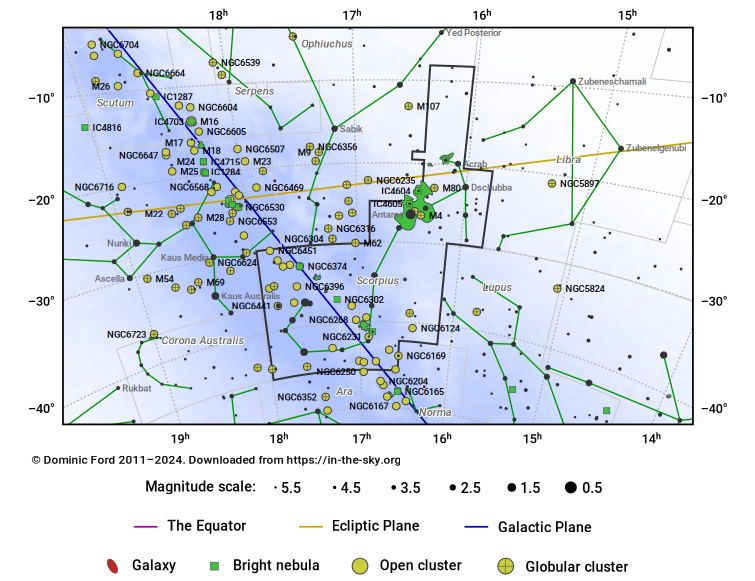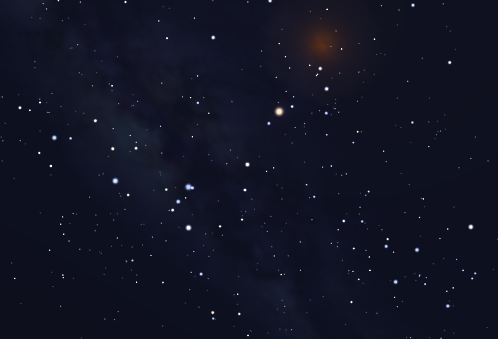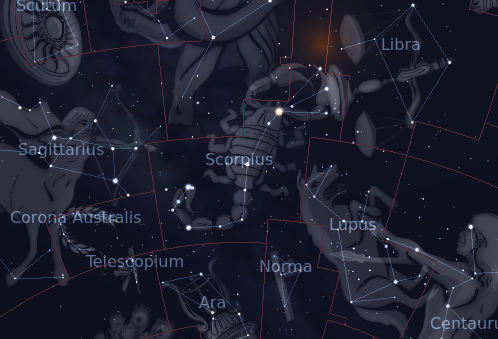The Constellation Scorpius
Scorpius is a southern constellation which appears highest in the evening sky in the months around May.
It is one of the twelve members of the zodiac, depicted as a scorpion. It should be noted that although astrologers still refer to this constellation by its old name, Scorpio, the modern constellations is called Scorpius. The Sun passes through it each year for around a week in late November.
Although the Sun spends only a few days in Scorpius each year, it is a moderately sized constellation. The northern tip of the constellation which represents the scorpion's claws is a narrow strip of sky (see the map to the right), which the Sun takes little time to cross.
The brightest star in this sky area is Antares, which marks the scorpion's head. South of this, the scorpion's curving tail is marked by a string of second-magnitude stars.
The plane of the Milky Way passes through Scorpius's southern reaches, and it is rich in star clusters, including 18 open clusters brighter than tenth-magnitude. Lying next to Sagittarius, where the Milky Way's center lies, Scorpius also has a number of bright globular clusters.
In Greek mythology, the scorpion depicted here is said to have stung Orion the hunter to death.
Ancient
1.2% of the sky
496.8 square degrees
The following constellations neighbor Scorpius: Ara, Corona Australis, Libra, Lupus, Norma, Ophiuchus, Sagittarius.
Hover the pointer over the name of an object to highlight its position on the starchart to the right, or click to see more information.
| Stars | Open Clusters | Globular Clusters | Galaxies |
| Antares (mag 1.1) | NGC 6231 (mag 2.6) | Messier 4 (mag 5.4) | NGC 6000 (mag 13.0) |
| Shaula (mag 1.6) | Messier 7 (mag 3.3) | NGC 6388 (mag 6.8) | IC 4597 (mag 14.4) |
| Sargas (mag 1.9) | Messier 6 (mag 4.2) | NGC 6441 (mag 7.2) | IC 4598 (mag 14.9) |
| ε-Sco (mag 2.3) | NGC 6281 (mag 5.4) | Messier 80 (mag 7.3) | IC 4596 (mag 15.0) |
| Dschubba (mag 2.3) | NGC 6374 (mag 5.5) | NGC 6496 (mag 8.6) | |
| κ-Sco (mag 2.4) | NGC 6416 (mag 5.7) | NGC 6144 (mag 9.0) | |
| Acrab (mag 2.6) | NGC 6124 (mag 5.8) | NGC 6139 (mag 9.7) | |
| Lesath (mag 2.6) | NGC 6322 (mag 6.0) | NGC 6453 (mag 9.9) | |
| τ-Sco (mag 2.8) | NGC 6242 (mag 6.4) | NGC 6256 | |
| π-Sco (mag 2.9) | NGC 6178 (mag 7.2) | NGC 6380 | |
| σ-Sco (mag 2.9) | NGC 6425 (mag 7.2) | ||
| μ¹-Sco (mag 3.0) | NGC 6259 (mag 8.0) | ||
| ι¹-Sco (mag 3.0) | NGC 6451 (mag 8.2) | ||
| G-Sco (mag 3.2) | NGC 6249 (mag 8.2) | ||
| η-Sco (mag 3.3) | NGC 6396 (mag 8.5) | ||
| μ²-Sco (mag 3.5) | NGC 6192 (mag 8.5) | ||
| ζ²-Sco (mag 3.6) | NGC 6400 (mag 8.8) | ||
| ρ-Sco (mag 3.9) | NGC 6268 (mag 9.5) | ||
| ω¹-Sco (mag 4.0) | NGC 6216 (mag 10.1) | ||
| ν-Sco (mag 4.1) | NGC 6404 (mag 10.6) | ||
| H-Sco (mag 4.2) | NGC 6318 (mag 11.8) | ||
| N-Sco (mag 4.2) | NGC 6444 | ||
| Q-Sco (mag 4.3) | NGC 5998 | ||
| ω²-Sco (mag 4.3) | |||
| ξ-Sco (mag 4.3) | |||
| c²-Sco (mag 4.6) | |||
| O-Sco (mag 4.6) | |||
| b-Sco (mag 4.6) | |||
| A-Sco (mag 4.7) | |||
| ξ-Sco (mag 4.8) |




